Exhibition texts
Rirkrit Tiravanija: DAS GLÜCK IST NICHT IMMER LUSTIG
Introduction
For more than three decades, Rirkrit Tiravanija has been expanding the possibilities of what can happen in an exhibition space. As part of his practice, the artist creates situations that offer space to eat and drink, play and rest. They encourage chance encounters, relationships and their failure – in other words: life. His early food actions left viewers equally confused and exhilarated as they decided on how to respond: whether to accept his invitation, join in and lend a hand, observe from a distance or simply pass by.
Raised between four continents as the son of a Thai diplomat, Tiravanija’s practice encompasses a myriad of cultural translations. Using multiple languages and a wide range of references – from works by other artists, filmmakers and architects to personal experiences – his open-ended proposals offer alternatives to the fixed and biased narratives that dominate cultural institutions.
Throughout his work, Tiravanija, who lives and works partly in Berlin, has often referred to cultural clichés and politics in Germany. In this vein, the title DAS GLÜCK IST NICHT IMMER LUSTIG (Happiness is not always fun) quotes Rainer Werner Fassbinder’s film Ali: Fear Eats the Soul (1974). Bringing together works from 1987 to the present, the exhibition asks what art is and what we can do with it.
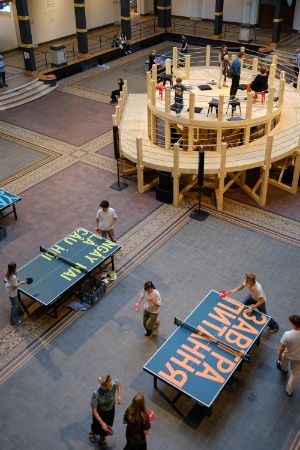
Rirkrit Tiravanija, untitled 2024 (السؤال هو غداً) (tomorrow is the ques-tion) (morgen ist die frage) (jutro jest pytaniem) (завтра это вопрос) (yarindir soru) (Завтра питання) (ngày mai là câu hỏi) / untitled 2024 (demo station no. 8), 2024, installation view, Rirkrit Tiravanija: DAS GLÜCK IST NICHT IMMER LUSTIG, Gropius Bau, 2024 © Gropius Bau, photo: Guannan Li
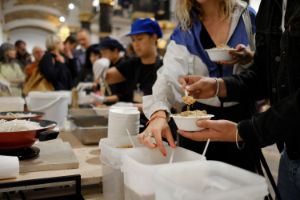
Thaipark Cooking Demonstration, Gropius Bau, 2024 © Gropius Bau, photo: Guannan Li
“I came to the point where I basically took the pot out of the case in the museum and cooked curry in it.”
– Rirkrit Tiravanija
What we eat and how we eat it can tell a lot about who we are and where we live. Preparing and sharing meals always has a social and political significance. In the early 1990s, when Rirkrit Tiravanija began serving food and drinks in exhibitions, these ideas played an important role. Visitors found themselves in situations where they were actively shaping the artwork. Not only the specific ingredients and dishes were put on display, but also the people and how they assembled and interacted.
These works offer visitors opportunities for action and are marked by an emphasis on process, ephemerality and chance – themes that had already been central to the Fluxus art movement in the 1960s. In Tiravanija’s case, however, they are accompanied by his notion of “cultural retrieval”: bringing items from art and ethnological collections back into life, allowing them to be understood as embedded in cultural contexts.
“For me when I see Buddha I see something else, and what I see is missing in the museum display.”
– Rirkrit Tiravanija
While attending art school in North America, Rirkrit Tiravanija often came across historical artefacts in museums that he recognised from Thai culture – Buddha statues, bowls and other vessels. How did they come to be in these museums? Why were they displayed sometimes as artworks, sometimes as everyday objects? Far from their places of origin, isolated on plinths or in vitrines, they were deprived of their potential use and function.
Towards the end of his studies, and well-versed in the strategies of the artistic movement of Institutional Critique, Tiravanija developed a body of work that addressed the methods and systems of thought foundational to the work of museums. Taking a critical view of European disciplines of art history and ethnology, he opposed the appropriation of objects by Western institutions. In particular, these early works examined the way exhibits are categorised and presented. In 1989, he first showed what he saw as the alternative: “take the pot out of the case in the museum and cook in it.” The idea was to use everyday objects for the purposes for which they had originally been made and invite viewers to think about their cultural significance and social function.

Rirkrit Tiravanija, untitled 1987 (text in red and black), 1987, installation view, Rirkrit Tiravanija: DAS GLÜCK IST NICHT IMMER LUSTIG, Gropius Bau, 2024 © Gropius Bau, photo: Guannan Li

Rirkrit Tiravanija, untitled 2014-2016 (curry for the soul of the forgotten), 2014-2016, installation view, Rirkrit Tiravanija: DAS GLÜCK IST NICHT IMMER LUSTIG, Gropius Bau, 2024 © Gropius Bau, Foto: Guannan Li
“We don’t recognise what we don’t see.”
– Rirkrit Tiravanija
What we know about the world, let alone our immediate surroundings, is rarely learned from direct experience. In many cases, knowing something involves recognizing something others have seen before us. In the early 1990s, Rirkrit Tiravanija investigated the question of which pictures and traditions shape our thinking. Critical of the way ethnology observes, names and categorises people, objects and entire regions, he identified a similar tendency in tourism, which also subjects “the other” to familiar patterns of perception. In several works, Tiravanija reversed this gaze, as when he photographed tourists taking pictures of what may have seemed foreign or special to them.
Historically, maps – and later photography and film – have often served as tools to codify the dominant gaze. Tiravanija, on the other hand, uses these means of recording to reflect on this gaze and focus attention on seeing itself: how we look at the world, and the conditions under which this takes place.
“All the work that I have ever made is about my position in the Western world, which I was trying to understand.”
– Rirkrit Tiravanija
“Mapping” is an artistic practice that investigates real or imagined spaces by visualising and plotting relationships. In the form of diagrams, charts or pictures, artists make connections between various different things, revealing hidden links and giving an overview of vague terrain, such as a political landscape.
As an artist who is at home in more than one culture, Rirkrit Tiravanija has applied procedures of mapping to his biography and his practice. By combining pictures of his artworks with references to precursors, research or events from his life, he has created “maps” of his artistic production. They offer orientation, but they are far from unambiguous. Instead, they invite viewers to keep finding new ways of relating to the images and information. At the same time, Tiravanija made works about the ways bureaucracy captures identity, for example in the form of passports and signatures. These works, too, can be understood as mappings: as a look back at Tiravanija’s constant travelling, as a reflection on identity and as an engagement with the genre of the self-portrait.
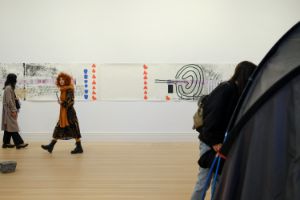
Rirkrit Tiravanija, untitled 2008-2011 (the map of the land of feeling) III, 2008-2011, installation view, Rirkrit Tiravanija: DAS GLÜCK IST NICHT IMMER LUSTIG, Gropius Bau, 2024 © Gropius Bau, photo: Guannan Li
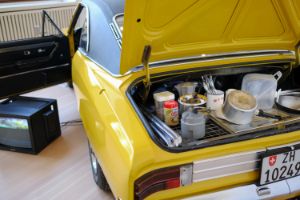
Rirkrit Tiravanija, untitled 1995 (bon voyage monsieur ackermann), 1995, detail, Rirkrit Tiravanija: DAS GLÜCK IST NICHT IMMER LUSTIG, Gropius Bau, 2024 © Gropius Bau, photo: Guannan Li
“I have always been travelling, it is about change, and about shifts, it’s about moving in order to remember that one is living.”
– Rirkrit Tiravanija
Travelling is a popular theme in Western art history. For centuries, artists have been travelling to other countries and depicting their impressions in drawings and paintings – often-times in a distorting way. In the 1990s, Rirkrit Tiravanija adopted this practice while reversing its codes and conditions. He understood his journeys as a symbolic countermovement, describing them once as “tourism against the West”.
On several occasions, Tiravanija has made his journey to a biennial or museum the subject of his art. By car, by bicycle or on foot, he traversed landscapes and visited places, cooking for the people he met on his way. The many hours of video footage from these journeys served as documentation, but they were also a reference to the temporal dimension of exhibitions – to the months of preparation and the elaborate procedure of transporting artworks that precedes the opening.
“There was always a questioning of the context and structures around what art would be.”
– Rirkrit Tiravanija
Visitors to exhibitions do not usually get to experience the workings of museums and galleries. The focus is on the art, with little being revealed about the people behind the scenes. The rules and customs that govern exhibitions and the commerce of art also usually remain hidden and unspoken. From the beginning, Rirkrit Tiravanija drew attention to these conditions. One way of doing this was to interrupt the normal course of events and turn things upside down.
Beginning in 1992, he used exhibitions to present the venues themselves – as art. In one case, he moved all of the furniture and inventory from the institution’s office into the exhibition space and relocated the staff among them. Another time, he had the gallerists reenact the history of the gallery’s founding and retell their everyday routines. The results were institutional portraits that referred to the practice of Institutional Critique used by artists since the 1960s to question conventions within the art world.
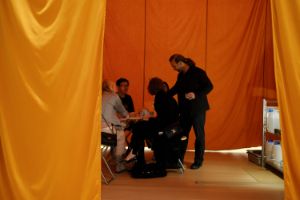
Rirkrit Tiravanija, untitled 1992 (cure), 1992, Installations, Rirkrit Tiravanija: DAS GLÜCK IST NICHT IMMER LUSTIG, Gropius Bau, 2024 © Gropius Bau, photo: Guannan Li

Rirkrit Tiravanija, untitled 2022 (chance will never abolish), 2022, installation view, Rirkrit Tiravanija: DAS GLÜCK IST NICHT IMMER LUSTIG, Gropius Bau, 2024 © Gropius Bau, photo: Guannan Li
“I usually describe my text works as road signs. Like when you drive by a big signage on a highway and pick up whatever the words are written on it.”
– Rirkrit Tiravanija
Communication is the basis for social coexistence. What can be said, and how it can be said, needs to be constantly negotiated, both in private conversations and in public. Language and text appeared early on in Rirkrit Tiravanija’s work in the form of handwritten notes, typed lists and recipes. Since 2003, the artist has also worked with slogans and catchphrases, often taken from political debates, works by other artists or the media. Occasionally, he also employs his own texts. Some of these slogans are used repeatedly over a period of years: translated into different languages, painted onto newspapers or directly on walls, printed on flags, t-shirts or ping-pong tables.
Many of Tiravanija’s works foster communication, as when visitors share a table to eat and drink, play pingpong or make music together. The challenges and tensions that emerge are part of the work: who has the courage to express themselves in public? Which rules apply and who makes them?
“Art was always trying to give people an opportunity to act freely. To think freely, to see freely, to hear freely.”
– Rirkrit Tiravanija
More and more museums and galleries see themselves as social places, where people come into contact with each other. As in most places, there are rules governing visitors’ behaviour. Participatory art, which encourages the audience to actively engage with the work, presents a challenge to such conventions. It seeks to create a space where social interactions can be put to the test. This approach is inspired, among other sources, by the art forms of the Environment and the Happening from the 1960s, which called on visitors to interact with art.
Rirkrit Tiravanija had these practices in mind when he began to actively involve the audience in his works. Observing how visitors took possession of the spaces and brought them to life, he decided to take a less prominent place in his own works, leaving the stage to the audience: since the late 1990s, he has been building platforms in exhibition spaces and inviting people to use them.

Rirkrit Tiravanija, untitled 1996 (rehearsal studio no. 6), 1996 / untitled 1998 (das soziale kapital) (sign), 1998, installation view, Rirkrit Tiravanija: DAS GLÜCK IST NICHT IMMER LUSTIG, Gropius Bau, 2024 © Gropius Bau, photo: Guannan Li